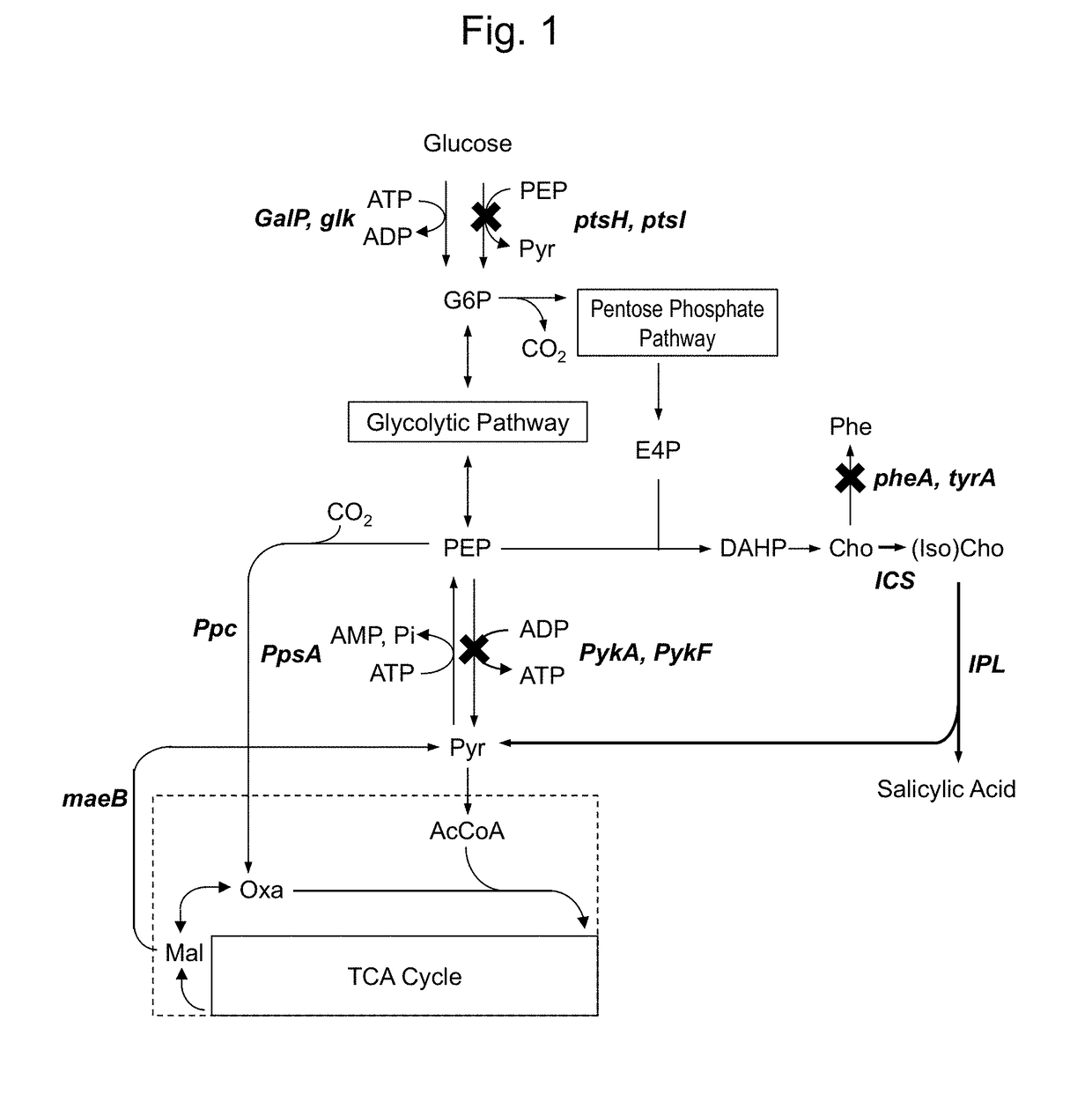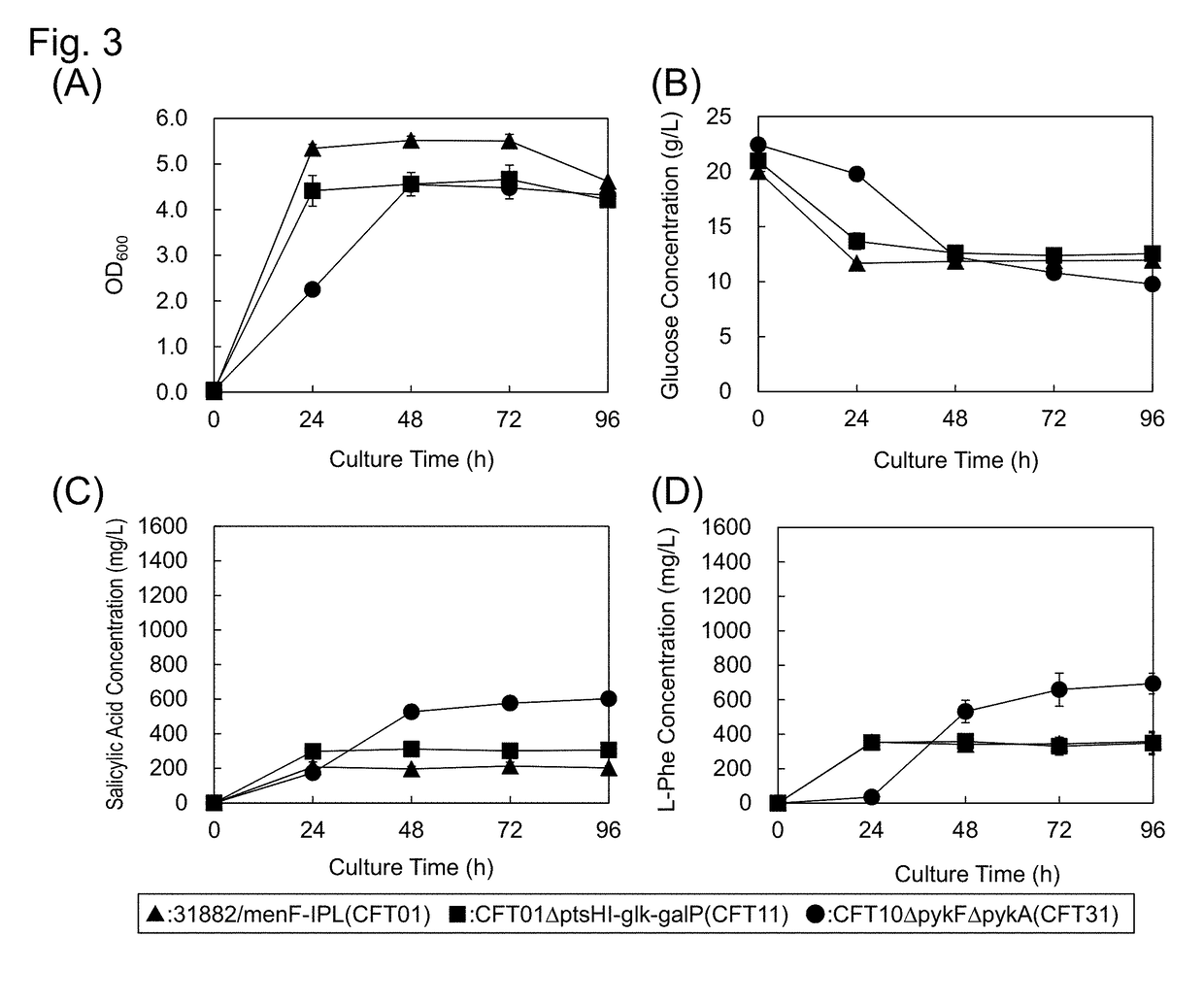Method for producing aromatic compound and derivative thereof
- Summary
- Abstract
- Description
- Claims
- Application Information
AI Technical Summary
Benefits of technology
Problems solved by technology
Method used
Image
Examples
example 1
[Example 1] Production of Gene-Deletion Cell Line
[0131]For producing a chorismic acid derivative, attempts were made to transform E. coli. As a parent strain, L-phenylalanine overproducing strain (ATCC31882) of E. coli was used.
[0132]Gene fragments encoding GalP and Glk were amplified by the PCR using a genomic DNA of E. coli MG1655 (ATCC700926) as a template, and using glk_NI_f (SEQ ID NO:23) and glk_NI_r (SEQ ID NO:24), and galP_NI_f (SEQ ID NO:25) and galP_NI_r (SEQ ID NO:26) as respective primers. The amplified fragments were tandemly inserted into the HindIII and BamHI sites of the pCFTdeltain (FIG. 2). The obtained plasmid was designated as pCFTdeltain-GG.
[0133]A gene deletion operation was carried out using Quick & Easy E. coli Gene Deletion Kit (Funakoshi, Tokyo, Japan) according to a protocol provided in instructions thereof.
[0134]A fragment for disrupting ptsHI and introducing PallacO-1-Glk-Galp was obtained through amplification by PCR using pCFTdeltain-GG as a template, ...
example 2
[Example 2] Production of Salicylic Acid Synthesizing Cell Line
[0139]The strain ATCC31882 was used for introducing genes encoding ICS and IPL to increase salicylic acid synthetic ability thereof. In this example, menF, entC and pchA were used as genes encoding ICS, and pchB was used as a gene encoding IPL.
[0140]As pchA and pchB gene fragments derived from P. aeruginosa, commercially available products (SEQ ID NOS:37 and 38, Invitrogen) were obtained, and codon usage of pchA and pchB was optimized for E. coli.
[0141]A gene fragment encoding pchB was amplified by PCR using a synthetic gene fragment resulting from codon optimization as a template, and using pchB_f (SEQ ID NO:1) and pchB_r (SEQ ID NO:2) as primers. The amplified fragment was inserted into the HindIII site of pZE12MCS (Expressys). The obtained plasmid was designated as pZE12I.
[0142]Gene fragments encoding menF and entC were respectively amplified by PCR using the genomic DNA of E. coli MG1655 as a template, and using men...
example 3
[Example 3] Introduction of Salicylic Acid Biosynthetic Pathway
[0148]Each plasmid produced in Example 2 was introduced into the mutant strains produced in Example 1 instead of the strain ATCC31882 for examining salicylic acid generation ability.
[0149]pZE12mI was introduced into the strain CFT1 having genes encoding Glk and GalP and containing ptsHI deletion so as to produce a strain capable of expressing menF and pchB. The obtained strain is herein designated as a strain CFT11.
[0150]The strain CFT11 was cultured for evaluation in an M9 minimal medium containing glucose as an only carbon source, in the same manner as the strain CFT01. The culture characteristics of the strain CFT11 are illustrated in FIG. 3. The amounts of salicylic acid and L-phenylalanine generated were as large as 311 and 358 mg / L, respectively. Although the productivity of salicylic acid was increased by 1.5 times as compared with that in the strain CFT01, the productivity of L-phenylalanine was substantially the...
PUM
| Property | Measurement | Unit |
|---|---|---|
| Temperature | aaaaa | aaaaa |
| Volume | aaaaa | aaaaa |
| Volume | aaaaa | aaaaa |
Abstract
Description
Claims
Application Information
 Login to View More
Login to View More - R&D
- Intellectual Property
- Life Sciences
- Materials
- Tech Scout
- Unparalleled Data Quality
- Higher Quality Content
- 60% Fewer Hallucinations
Browse by: Latest US Patents, China's latest patents, Technical Efficacy Thesaurus, Application Domain, Technology Topic, Popular Technical Reports.
© 2025 PatSnap. All rights reserved.Legal|Privacy policy|Modern Slavery Act Transparency Statement|Sitemap|About US| Contact US: help@patsnap.com



